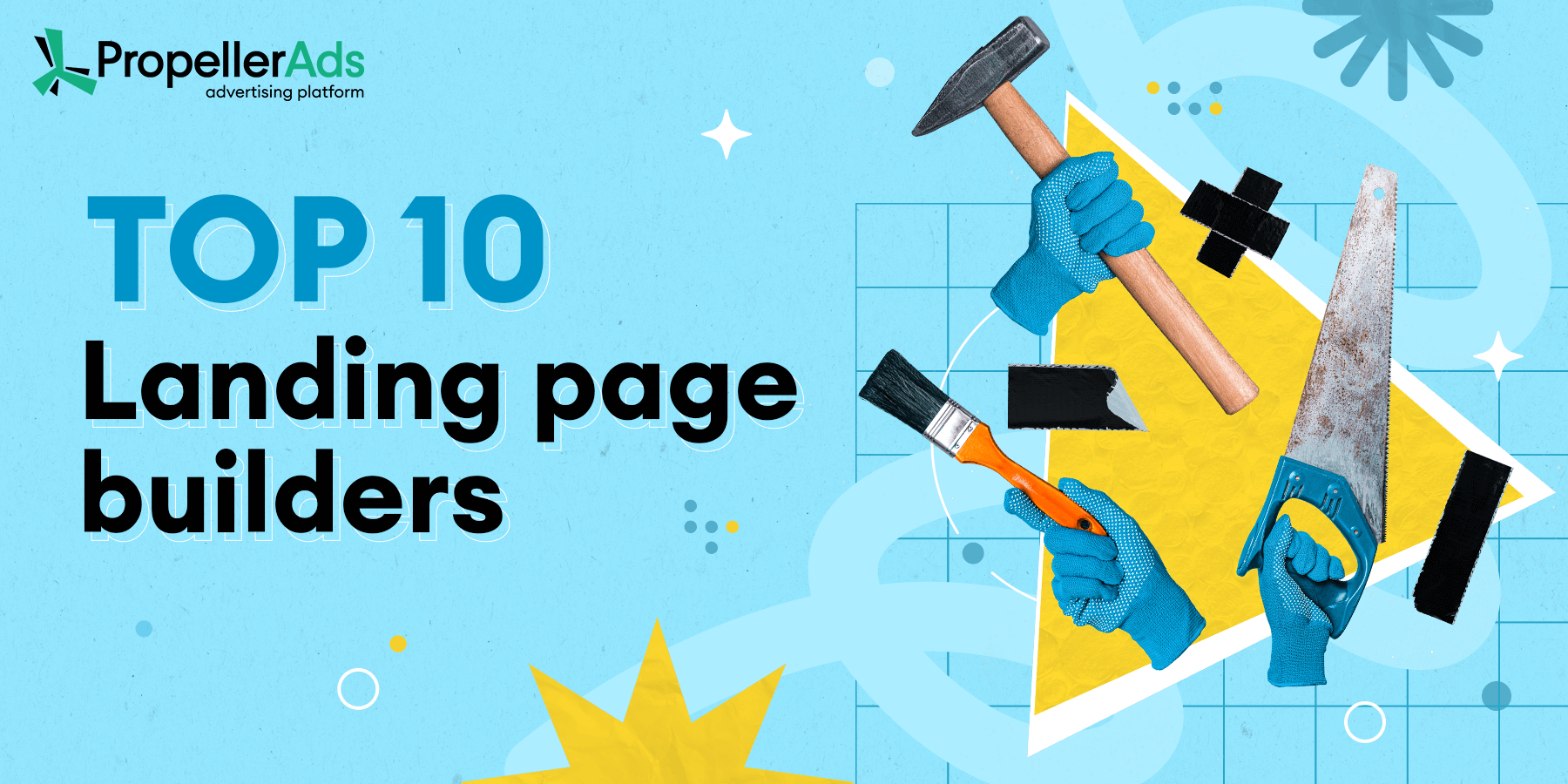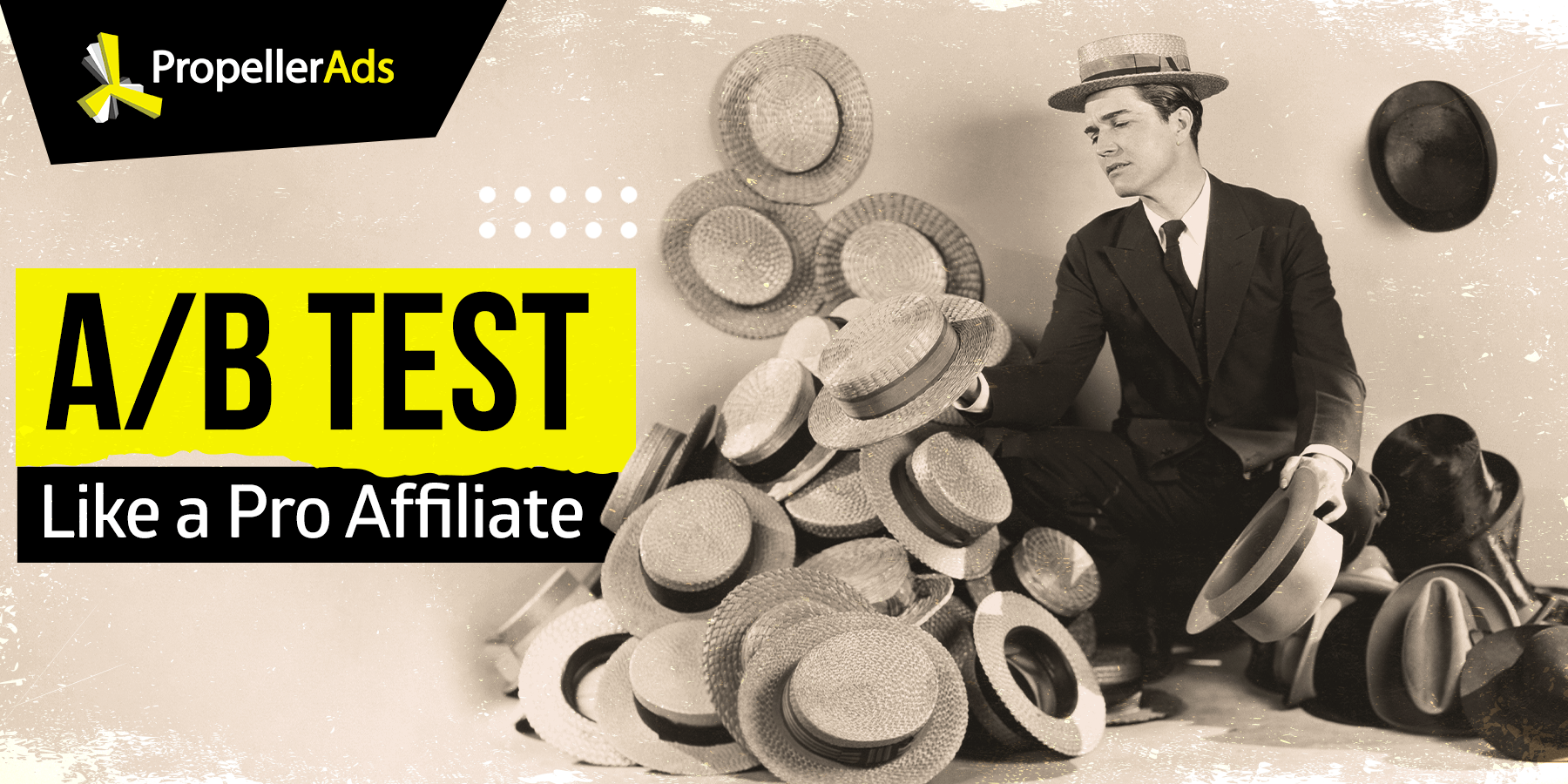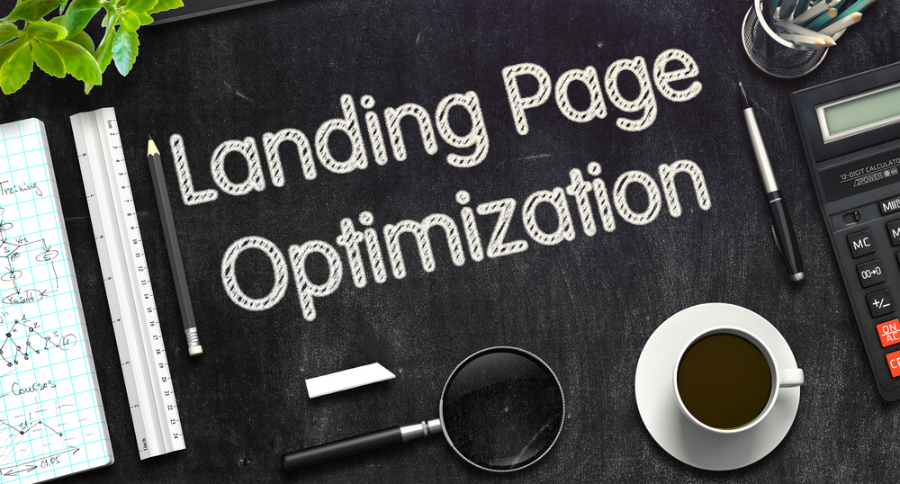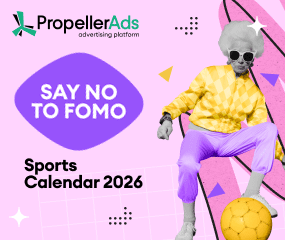The Bounce Rate Trap: How to Spot and Avoid Wasted Clicks
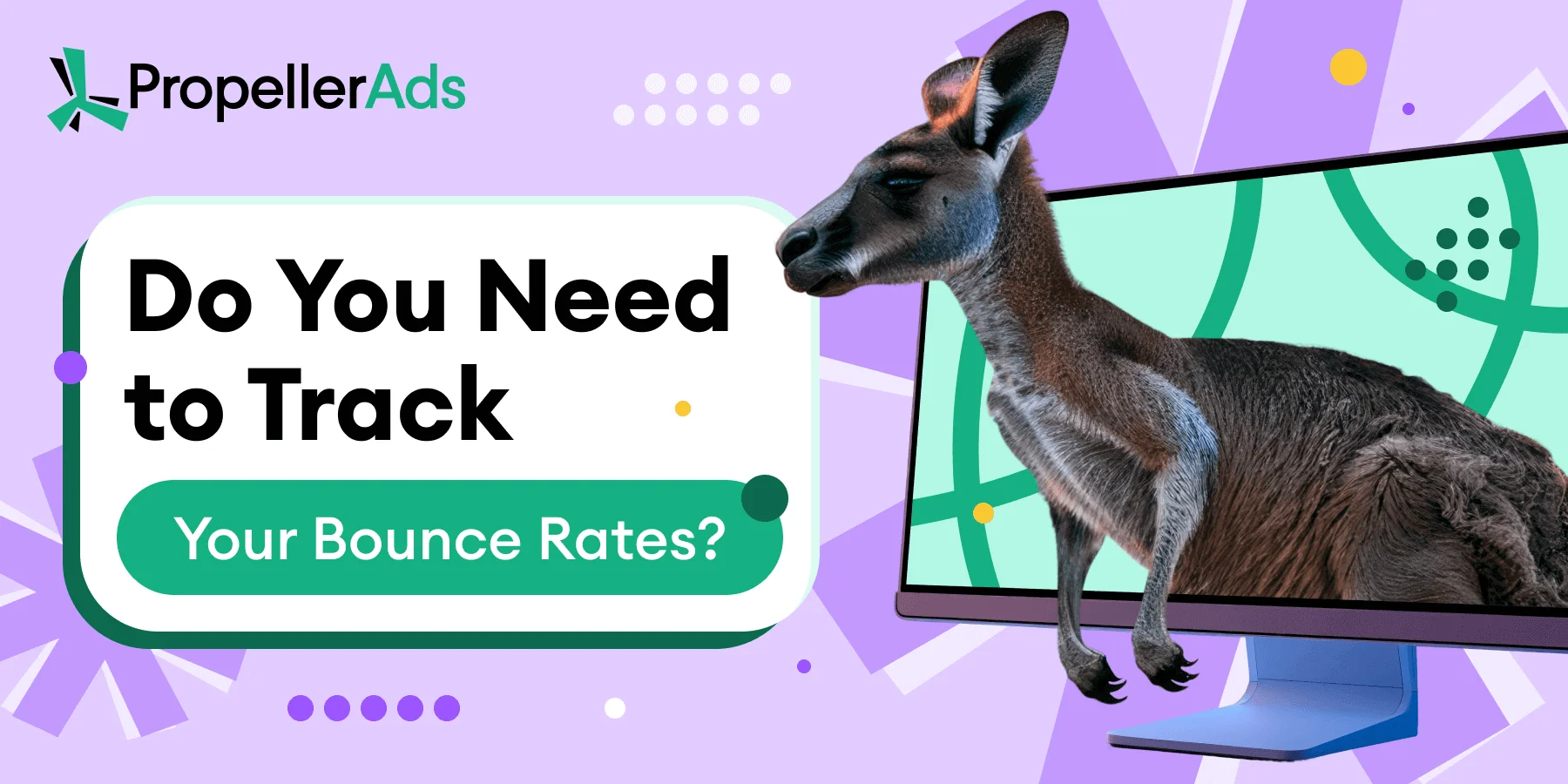
Some affiliate marketers consider bounce rate as a vague blogger’s metric. Well, like something only content publishers should worry about, to see if people actually read their articles. Why bother with that?
We’ve seen this approach first-hand when talking to different media buyers and asking them how they measure bounce rate. For many, it’s not even in the top-10 metrics lists to check.
That’s understandable. However, bounce rate can show you many hidden issues that hurt your CR. Fake clicks? Wrong traffic? Slow loading pages? Or maybe a landing that just doesn’t match the ad – whatever, bounce rate might highlight where your money is leaking right now.
What is Bounce Rate And Why Is It Important?
Bounce rate is simply the percentage of users visiting your page and leaving immediately. In media buying, it’s usually the landing page.
To make it perfectly clear, here’s an example: 100 users click your push ad and end up on your landing page.
- 70 of them closed the page immediately, without making a conversion – say, loading an app.
- 30 of them converted, or at least clicked around or made a couple of page scrolls.
In this case, your bounce rate is 70%.
Why track it, though? The landing page is the key step in your funnel: it has to push visitors toward the action that brings you profit. If users bounce right away, they won’t convert, so your budget goes to waste.
As Ruslan, AffTrends CEO, puts it, it even has an indirect impact on a conversion price.
‘The higher the bounce rate, the fewer people reach the form, so the conversion rate drops, and CPA goes up.’
Of course, it’s unlikely to become a main metric. For example, here is what Ruslan says about his team’s approach:
For me, this is more of a secondary metric, since I mostly focus on EPC and ROI. Bounce rate is a signal, though: if it’s too high, it means either the traffic is low-quality or the landing page doesn’t engage the audience.
So, bounce rate is the signal – the indicator! And you shouldn’t ignore it. Just look at one example of how it can make you a gentle hint.
A Quick Case Study: How Design Changed and Bounce Rate Quietly Highlights It
Dustin Sparks, an expert in landing page optimization, shared his experience with his client, a private college, who wanted to get more applications from prospective students.
So, their goal was to:
- Boost the number of applications through the landing form
- Make the cost of a lead lower through PPC (Google Ads)
The idea was simple: move the form higher on the page so people see it right away and don’t get distracted. To do this, they removed the top menu and placed the form above the fold — the part of the screen you see without scrolling.
What’s in the result? Compared to the previous landing page version:
- CR grew to 13,64%
- There were +336% conversions
- Bounce rate dropped to 28,7% from 32,5% – and that’s the most curious part for our article
This case shows an important thing: even if bounce rate isn’t your main target metric, it often reflects whether your changes make sense for users. When the design became simpler and the form easier to notice, conversions skyrocketed — and bounce rate modestly confirmed the improvement.
Note: Don’t confuse bounce rate with exit rate. The bounce rate is only for visitors who leave after viewing only one page of the whole site. Exit rate shows the percentage of visitors who leave your site from a specific page – this page is where their journey ends. However, they might have visited other pages before.
So:
- When someone lands on your blog post and leaves right away, that’s a bounce
- When they read three articles, and then leave from that same blog post, that’s an exit
For affiliates who mainly work with single-page landers, the exit rate metric brings almost no value.
Getting back to our very first example, we saw a 70% bounce rate. Seems extremely high, right? Still, it’s not always an issue; let’s have a quick look at the real market averages.
What is a Normal Bounce Rate?
Good news: There’s no specific benchmark that you must reach. The bounce rate averages depend much on a vertical, or a particular landing, and even the conversion you want a user to perform. Here, for example, is what Ruslan says:
‘On average, up to 40–50% across all verticals and GEOs is an acceptable norm. However, for financial offers/credit campaigns, a bounce rate higher than 30–35% should raise concern, since this audience is generally more motivated.’
Pete Garmashov from PropellerAds Chat added that Pop traffic can sometimes show bigger bounce rates on the landing pages, but still bring nice conversions – just by its nature.
Meanwhile, push traffic, for example, usually has lower bounce rates. It’s pretty obvious: users from Push notifications are more engaged, as they’ve already chosen to subscribe and then clicked the ad on purpose. So, here, the bounce rate can be about 40%-60%.
We gathered the most typical verticals and traffic types and their average in this table:
| Traffic type/Vertical | Average bounce rate |
| Landing pages overall (across all industries) | 60-90% |
| E-commerce/Retail | 30-45% |
| Travel/Tourism | 30-50% |
| Finance/Loans | 30-50% |
| Media/News/Blogs | 60-90% |
Why Do I Get High Bounce Rates?
If you see your bounce rates are rising too high, and you don’t fit even into these encouraging enough benchmarks, it still doesn’t mean you’re in trouble.
Let’s first look at what’s considered normal.
‘Don’t Worry, That’s Okay’ Cases
- Your conversion doesn’t require a long visit
As one of our media buyers, Ettore, mentioned on our PropellerAds chat: If the action is just submitting the email, why should the user be doing another action or navigate the website?’
And don’t forget to join our PropellerAds Chat, it’s a gold mine of affiliate insights
As we mentioned earlier, some verticals naturally have higher bounce rates. If a user only needs to take a quick action on the landing page, that alone explains part of it. In such cases, as long as your CR looks good, there’s no need to worry about bounce rates.
So, it’s okay for short-form landing pages – something like this, quickly created by GPT just to give you an idea:
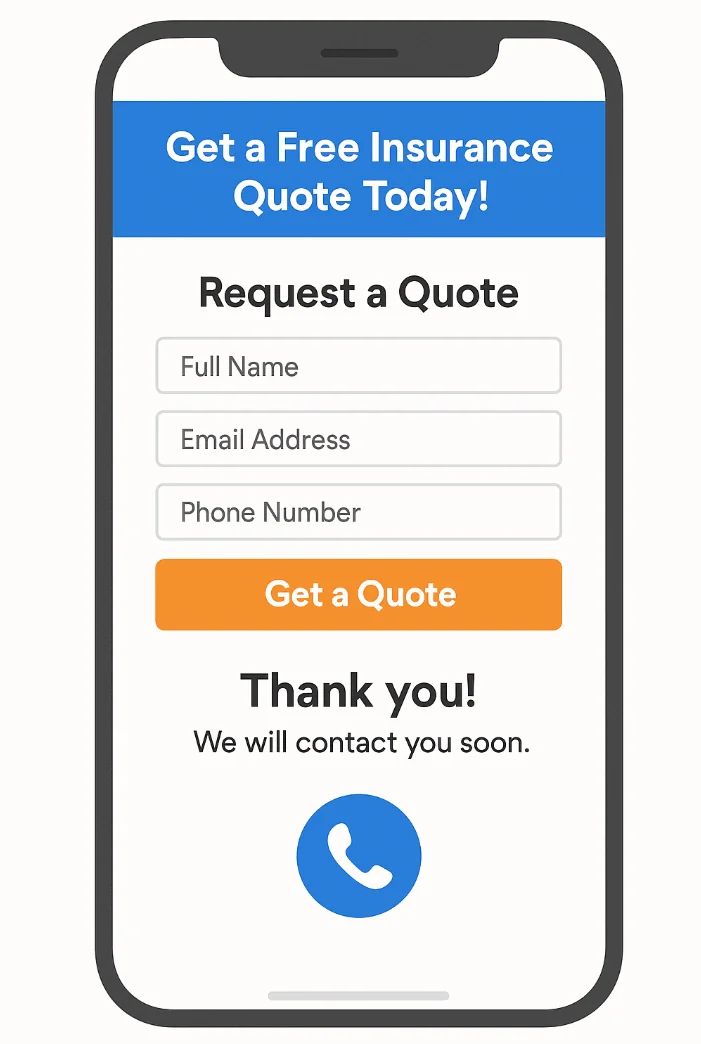
With such a landing page, users convert and then exit, leaving your bounce rate high, but with the goal achieved.
- You’re tracking it the wrong way
The latest version of Google Analytics (GA4) doesn’t count bounce rate as a standalone metric. Now, it’s the opposite of ‘engagement’, and this creates some issues when you want to actually estimate a bounce rate.
Look: GA4 counts engagement as ‘zero’ if a user doesn’t perform any extra action, like scrolling or a click. So, imagine someone actually read your page for 5 minutes – it’s definitely not a 100% bounce rate already! However, GA will still show something like this:

To make tracking more accurate, don’t forget to set up micro-events (scroll depth, timers, and clicks. This way, a really engaged visit won’t be counted as ‘0 seconds with a 100% bounce rate’.
Alternatively, you can try easier tools like Plausible or Matomo. They already track scrolls and clicks without much setup.
Cases Where You Should Pay Attention
Now, the part where bounce rate can be a real indicator of a hidden pitfall that ruins your performance. Let’s take a look:
- Your landing page is too slow
It’s especially critical in markets where mobile Internet can be less stable – for example, in Vietnam or parts of Africa. However, no matter the actual GEO, hardly any users on 3G will patiently wait for a big video or heavy graphics to load. If the page doesn’t open fast and smoothly on mobile, you lose them before they even see your offer.
Ruslan confirms it as the number one issue with bounce rates:
‘Slow loading comes first. You should always optimize your landing pages for speed and weight (including images).’
Let’s cure it right away! Use free tools like Google PageSpeed Insights or GTmetrix. They show you how quickly your landing loads on desktop and mobile, and what elements make it heavy (images, scripts, videos).
Once you manage to find them, try to:
- Compress too heavy images
- Cut down scripts
- Consider deleting autoplay videos
- Avoid heavy animation
Here is a small case study from Renault, who decided to study how the content loading on their landing pages impacts user behavior: stay, or go, and send their requests or not.
To check this, they optimized page loading so that the Largest Contentful Paint — the time it takes for the biggest and heaviest element to appear — would load immediately. Here is how they did it step by step:
- Split the code into smaller parts and load only what is needed for each specific page
- Used fast servers (CDN) and caching to make pages open closer to the user
- Optimized images (modern formats like WebP and different sizes for different devices)
- Enabled ‘lazy loading’ — images and videos load only when the user scrolls to them
The results were pretty clear: when the main content loads faster, bounce rates go down and conversions go up. With LCP under one second, conversions rose by 13% and bounces dropped by 14 points. But when LCP was slower than 1.6 seconds, bounce rates increased and conversions fell. Do you now see how bounce rate is closely tied to speed?
Of course, as media buyers, you don’t always need to dive that deep into technical optimization. But the fact remains: even a one-second speed-up can lower the bounce rate by 14% and bring +13% conversions. Hard to ignore this, right?
- Your creative is irrelevant to a landing page
We found a curious case study on our PropellerAds Chat. One of our partners added attractive female images to his landing pages just to grab some attention. These (totally dressed, mind you!) girls’ pics had nothing to do with the offer itself, though. And, he complained about his high bounce rates.
What did the colleagues suggest? Here’s one take: ‘A user is watching, say, a movie, and suddenly a pop-up ad with an attractive woman appears. Is that relevant for them at that moment? Not really. And, such pictures are everywhere online anyway, so nothing feels special. That’s why the bounce rate goes up.’
Let’s cure it right away! Debates about clickbait images and how they affect CR could be a whole separate article. But in this very case, using pictures that have nothing to do with your offer will almost always push your bounce rate up.
Also, sometimes the design itself can turn users away. Try testing different layouts and styles for your landing page. We’ve shared a few design tips here:
- You have traffic quality issues
Click fraud and bots can also ruin your numbers. These are fake clicks made by scripts or fraudsters. They visit your landing page but never interact, and it counts as a 100% bounce.
For example, WD Strategies reports that up to 48% of clicks coming from LinkedIn can be fraudulent.
Another issue is shady ad networks. When they run your ads on random, untested partner sites – or when someone buys cheap traffic on some Fiverr gig for $5 – you usually get low-quality visitors: people who were never really interested or who clicked by mistake. They land, find nothing relevant, and bounce immediately – hello, sky-high bounce rate.
Let’s cure it right away! Even a great landing page can’t fight against bad traffic. Start by filtering suspicious traffic sources, turn off low-quality placements, and double-check where your clicks are really coming from. This way, your bounce rate will show the real picture, not bot noise.
- You didn’t think much of the UX
Yes, most landing pages in the same affiliate verticals look very similar because everyone relies on the same proven templates. The angles have already been tested many times, so affiliates usually stick to standard, tested setups that are guaranteed to work across devices.
So if you decided to build a brand-new page from scratch, things can easily go wrong. If users can’t find the sign-up form, don’t understand the offer, or the page looks broken on mobile, it can quickly drive your bounce rate sky-high.
Here are the examples of bad UX elements mentioned by Ruslan:
‘The same common reasons spoil UX and the overall bounce rates. To name just a few: no mobile optimization so the page breaks on smaller screens, poor UX with walls of text and buttons that don’t even work, or annoying pop-ups and redirects that chase users away. Even one of these issues can be enough to make people leave immediately.’
That’s another quick GPT-created mockup — to show what we mean and give you a little smile.
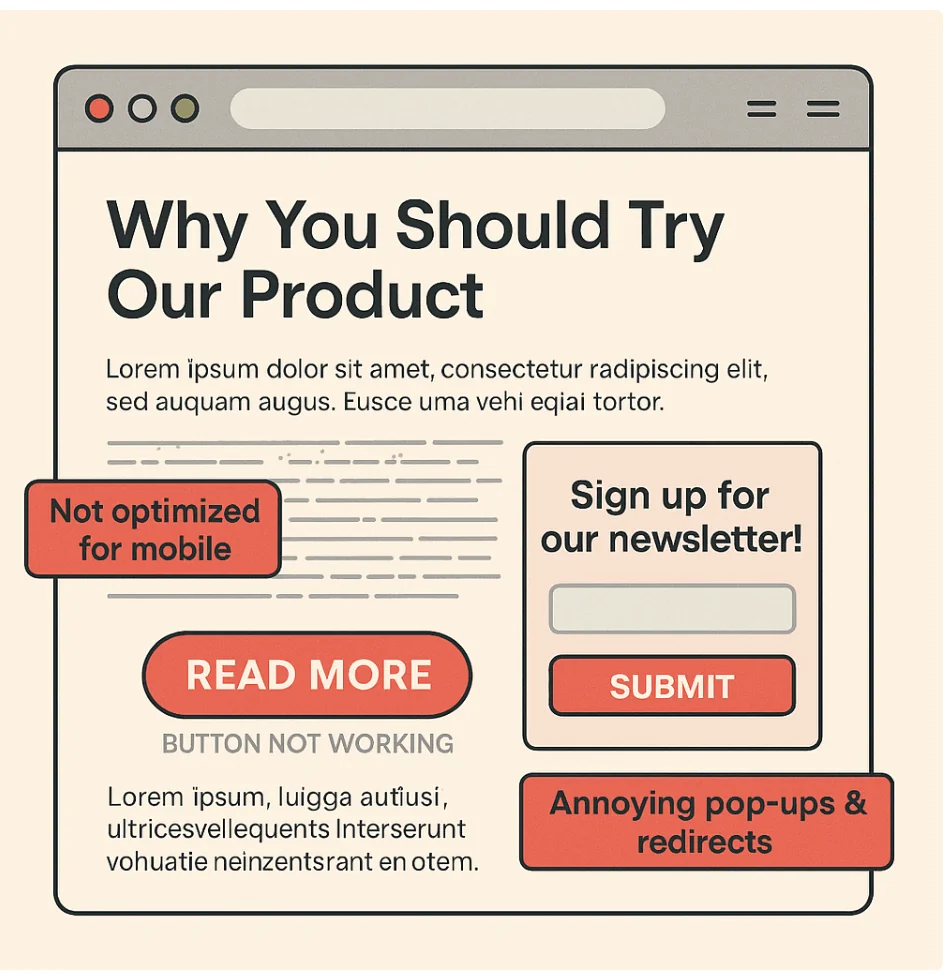
Let’s cure it right away! We could write a whole separate article about landing page design – and luckily, we already did before. Here it is:
To Sum Up
Bounce rate is not always about the landing page issue, but also your traffic and your offer. While you don’t need to check it every single time in your stats, it’s one of the key metrics to give you a serious hint on where the budget flows.
So… made it to the end? Now go check your bounce rate — just in case.
Join our Telegram for more insights and share your ideas with fellow-affiliates!
